Kelly Savage is a domestic violence survivor. Kelly Savage has been in prison since 1995.
In 1995, Kelly's abusive husband killed her son Justin after she put her children to sleep and left the house to run errands.
Although Mark Savage beat his three year old son to death while Kelly was gone, she was arrested along with for not preventing the death.
The state of California believed Kelly should have left her husband and taken her child with her.
During her trial, the prosecution scoffed at the idea that Kelly had not left her husband out of fear associated with a history of domestic violence. The prosecutor said Kelly enjoyed being beaten.
Kelly was sentenced to live behind bars without the possibility of parole for the rest of her life.
Huh, Kelly got life?
Are you kidding me?
Nearly 30 U.S. states, including California, have failure-to-protect laws that criminalize a parent’s inability to protect her children.
In many cases, the woman’s abuse is not taken into consideration or, as happened in this woman’s case, it is even used against her in court.
A petition on Kelly's behalf states:
Kelly was not present for her son’s killing, but the DA blamed her for not escaping and saving her children sooner, ignoring the very real and documented dangers associated with attempting to leave an abusive partner. The DA also exploited Kelly's history of abuse to suggest that she didn't run because she enjoyed the beatings, and sacrificed her son to "please" her abusive husband.
California’s Intimate Partner Battering legislation allows Kelly to petition for a review of her conviction by introducing expert testimony about her abuse that was not allowed in her trial. Kelly’s defense was severely harmed by the absence of expert testimony to explain how prolonged intimate partner battering was relevant to her case. Kelly’s lawyer and trial judge fought her request for an expert in domestic violence who could have testified on her behalf.
It is Prison Friday at Scission.
For Kelly Savage it is just another day in confinement.
The following is from the Prison Activist Resource Center.
Why Is California Keeping Kelly Savage in Prison for a Crime She Didn't Commit?
But 15 hours before their escape, while she was running last-minute errands, her husband beat her 3-and-a-half-year-old son Justin. The boy died. Both Mark and Kelly were arrested.
At her trial, the prosecutor argued that Kelly enjoyed the beatings and that, because she had not fled, she was equally at fault for her son's death. Both were convicted of torture and first-degree murder and sentenced to life without the possibility of parole. In 1998, nearly three years after her son's death - years Kelly Savage spent in jail - she entered California's Valley State Prison for Women. This year marks her 19th in prison.
But her story - and her imprisonment - is neither unique nor exceptional.Nearly 30 states, including California, have failure-to-protect laws that criminalize a parent's inability to protect her children. In many cases, the woman's abuse is not taken into consideration or, as happened in Kelly's case, is even used against her in court. But Section 1473.5 of the California Penal Code now allows women like Kelly, who did not have expert testimony about battering at her trial, a second chance.
A History of Abuse
Kelly Savage was 23 when she was arrested for her son's death. But those 23 years were marked by a history of physical and sexual abuse beginning when she was 3 years old. As a child, she was repeatedly beaten and raped by a number of people, including her father, her uncle, her stepmother's stepfather, and a trusted friend of her father. Although the police had been called several times, they did nothing to stop the abuse or remove Kelly from her abusers.
She married at 18, but her husband also turned out to be physically and sexually abusive. She left him two months before her son Justin was born in December 1991.
The following year, she met Mark Savage. Like the other men in her life, he quickly became both physically and sexually abusive. "I was about to leave him when I found out I was pregnant with my daughter," she said in a phone interview from prison. Noting that she had been raising Justin as a single mother, she explained, "I made a stupid choice. I didn't want to have two kids without a father, so I stayed." Their daughter Krystal was born on November 25, 1993. The couple married the following month.
Krystal's birth did not stem the abuse. Her husband regularly choked, pushed, shoved and yelled at Kelly. He blackened her eye on at least two occasions, burned her with cigarettes and broke her toe.
By Mother's Day 1995, Kelly had had enough. At the local community college, she found a flier for a domestic violence hotline. When she called, the hotline counselor advised her on how to escape. Kelly began preparing, including gathering copies of her children's birth certificates and other paperwork. In the meantime, her husband's abuse escalated. When Mark found her packing the children's photos and birth certificates, he struck her, nearly breaking her hearing aid. She managed to convince him that she had not been packing them. He also tied her to the couch and tried to tattoo his name on her leg using a sharpened paper clip. "I still have a tattoo of an 'M' on my right ankle from this incident (although it is covered by the tattoo of my children's names)," Kelly told Truthout. This type of escalation is so common that it has a name - separation violence. Fearing the impending loss of control, batterers increase their violence and are more likely to kill their family members as they are attempting to leave or have just escaped.
The night before Justin's death, Kelly woke to her son screaming and her husband yelling. When she tried to enter Justin's room, she reported that Mark pushed her out before tossing the boy onto the bed. It was the first - and only - time she had ever seen Mark hit Justin. Usually, she recalled, the boy seemed attached to his stepfather. In court later, she learned that this was traumatic bonding, in which an abuse victim, in an attempt to deflect further harm, forms an emotional attachment to his abuser.
The following day, Kelly put the children to bed at nap time before running some last-minute errands. Her bags, including the children's birth certificates and photos, were packed. When she returned home, Justin was no longer breathing. She called 911, but it was already too late.
In court, the prosecutor used her history of abuse to argue that Kelly enjoyed being beaten and that she allowed her husband to beat Justin in order to please him. Although her lawyer employed a psychologist, Dr. Phyllis Kaufman, as a defense witness, she was not an expert in battered women's syndrome or intimate partner battering. Instead, she testified that Kelly had post-traumatic stress disorder stemming from a history of childhood abuse and that people suffering from PTSD sometimes block out or fail to hear signs of danger.
After entering prison, Kelly discovered that Kaufman had been struggling with a similar case in her personal life at the same time: Kaufman's 3-year-old granddaughter had been tortured and murdered by her daughter's abusive boyfriend. As Kaufman was preparing to testify at Kelly's trial, her daughter was awaiting trial at the Sacramento County Jail while her remaining grandchildren were in separate group homes. In prison, Kelly met her daughter whom she is now training to be a peer educator in domestic violence.
When a History of Abuse Becomes a Failure to Protect
As Kelly Savage discovered when she met Kaufman's daughter, her situation is neither unique nor exceptional.
"Abuse is the dominant reason that so many women are locked up," Colby Lenz, a volunteer organizer with the advocacy group California Coalition for Women Prisoners, told Truthout. "Either they didn't speak out or they were at the scene of the crime or they were defending themselves or they didn't stop their abusers from harming or killing their children."
In California, a prison study found that 93 percent of the women who had killed their significant others had been abused by them. Sixty-seven percent of those women reported that they had been attempting to protect themselves or their children. However, there are no comprehensive studies on the number of women incarcerated for failing to protect their children. There is, however, anecdotal evidence that shows a broad pattern across the country. A recent investigation by BuzzFeed News, for instance, found 28 mothers incarcerated in various states for not protecting their children despite evidence that they themselves were being abused.
Now a domestic violence peer educator inside the prison, Kelly has found that approximately 70 percent of the women around her have experienced abuse. She recalled one class of 49 women in which only four of the women reported that they had no abuse in their homes before the age of 18. Of those four, only one woman said that she had never experienced abuse in her adult life.
She has also met numerous women in her situation. She recalled a planned workshop for women imprisoned specifically for the harm or death of a child. More than 70 women, including Kelly, filled out the four-page survey to participate. The number of women who could have participated is probably higher, Kelly said, but because of the stigma and threats of violence against women who allow a child to be hurt, many (including Kaufman's daughter) continue to keep quiet.
Losing Both Her Children
Kelly's daughter Krystal was 18 months old when her brother Justin was killed. Given her history of sexual and physical abuse at the hands of relatives, Kelly decided not to ask her family to take care of Krystal. Instead, Mark's mother came from Florida to take custody.
The last time Kelly saw Krystal was in October 1995; the girl was nearly 2 years old. "I was supposed to have a one-hour contact visit, but I didn't get a full hour," Kelly said. She recalled that both Mark's mother and the social worker warned her not to say anything about Justin to her daughter. "They also told me not to be surprised if she didn't know who I was since it had been two months since we saw each other," she said. "But she knew right away who I was." Mark's mother took the toddler to Florida soon after the visit.
For the next two years, their only communication was through phone calls. "We'd sing the Barney song together," she remembered. But when Kelly refused to accept a plea bargain that would enable Mark to face a lesser sentence, all contact was cut off. Kelly wrote to her daughter via Mark's sister, who promised that she would one day show her letters to the girl. But even then there were rules. "They said I wasn't allowed to be called mom. I had to be called Kelly or else they wouldn't give her the letter," she said. But Kelly wrote to her daughter every month. "I just kept trying."
In 2007, Krystal finally got to see her mother's letters. She had left her grandmother's house and moved in with Mark's sister, who had saved the letters for her. After reading them, she contacted her mother. "Half the time she's angry and half the time she just wants to know what really happened," Kelly said.
"My Only Hope"
In 2001, California passed Section 1473.5 of the Penal Code, which allows incarcerated abuse survivors convicted of defending themselves to file a writ of habeas corpus if expert testimony about battering and its effects was not presented during their trial. In 2004, it was expanded to allow abuse survivors convicted of any violent felony to file a petition. The law's expansion meant that Kelly was eligible to petition for a review of her conviction by introducing expert testimony about her abuse that had been absent at her trial.
In 2002, advocacy groups Free Battered Women, Legal Services for Prisoners with Children, the California Women's Law Center and the USC Post-Conviction Justice Project established the Habeas Project to recruit and train volunteer legal teams (attorneys, advocates, investigators and expert witnesses) to work with abuse survivors filing habeas petitions under the new law. By 2007, its efforts had helped free 19 battered women with life sentences. However, despite its best efforts, many women still lack an attorney to help them navigate the process and the Habeas Project closed in 2013 due to a lack of funding. While advocates, including formerly incarcerated battered women, continue to reach out to attorneys, the demand far outweighs the supply. "What's very apparent is the lack of resources for women trying to petition for relief, " noted Lenz, the organizer with California Coalition for Women Prisoners.
When Kelly first learned about 1473.5, she did not apply. Then she began training to become a peer educator in domestic violence, which required 387 hours of workshops with advocates, social workers and others in the field. After one workshop, Kelly spoke to the facilitator, a social worker from Weave, a battered women's shelter in Sacramento. The social worker told her about different training, which examines the effects of child abuse on the mother, and about one mother she had worked with whose husband had killed all three of their children while she was out of the house. "You can't beat yourself up to the point where you give up," Kelly recalled the social worker telling her. Kelly took those words to heart. Thus in 2005, three days before the 10-year anniversary of her son's death, friends helped her fill out the paperwork to request a lawyer to help navigate the habeas process.
The Habeas Project connected Kelly with the law firm of Morgan, Lewis & Bockius. Two of the firm's attorneys, Christina Harper and George Cumming, took on Kelly's petition pro bono. After reviewing her case, Cumming was appalled. "Kelly was convicted by the exploitation of every single derogatory gender stereotype," he told Truthout. "The prosecutor argued that Kelly didn't leave because she enjoyed the beatings and that she allowed her husband to beat Justin in order to please him. But anyone who knows anything about battered women knows how horribly difficult it is for them to leave."
Cumming and Harper wrote Savage's habeas petition. In addition, they also wrote a six-page letter to Kamala Harris, California's attorney general, requesting a meeting to discuss the case. They also included 100 pages of declarations from domestic violence experts. Harris' office declined to meet with them. Sister Helen Prejean, with whom Cumming had worked on a death penalty case in Texas, also wrote to Harris, asking that she meet with Cumming. Harris' office did not respond.
Kelly's petition is currently before the Court of Appeals, which has twice asked Harris to file a response to her petition. In both responses, the attorney general has made clear that she opposes Kelly's petition, arguing that since her lawyer retained Kaufman, a clinical psychologist, Savage had not been prevented from introducing evidence of battered women's syndrome at her trial. In her second response, she argued that 1473.5 was not meant to "eviscerate the well-established rule that prohibits defendant from relitigating matters on habeas corpus that were previously litigated and resolved at trial simply because she has secured a more favorable opinion." In fact, the response continues, "A contrary finding would leave state court judgments vulnerable to indefinite collateral attack based on the evolving state of the expert's disciplinary studies in Battered Women's Syndrome/Intimate Partner Battering."
Cumming and Harper aren't buying that argument. "If the statute doesn't apply to Kelly, then it doesn't apply to any battered woman," Cumming said.
But Harris' office has, on at least one occasion, withdrawn its opposition, Harper noted. When Sara Kruzan, imprisoned since age 16 for killing her abusive pimp, filed her habeas petition, Harris originally opposed it. Kruzan first met George Gilbert Howard when she was 11. He was 31. When she was 13, Howard raped her, and then forced her to begin working as a prostitute. When she was 16, she killed him. She was originally sentenced to life without parole plus an additional four years. In 2010, after she had spent 16 years in prison, her sentence was commuted to 25 years to life. Her habeas petition argued that if evidence of intimate partner battering had been introduced at her trial, the results might have been different. Harris' office originally opposed Kruzan's petition, arguing that Kruzan's circumstances did not fit the definition of cohabitation or a dating relationship. But in 2012, it withdrew its opposition, stating that it recognized that, although Kruzan's exploitation was not from domestic or dating violence, the reasoning behind 1473.5 still applied. Kruzan was released in October 2013 after spending 18 years in prison.
"It's highly unusual for the appellate court to ask the attorney general to file a second response to a habeas petition," Cumming said. He is hopeful that the request means that the court is seriously considering Kelly's petition and will rule favorably. If it does, Kelly could be granted a new trial where an expert witness could testify on her behalf.
Meanwhile, the California Coalition for Women Prisoners, which has worked with Kelly for over a decade, has started aChange.org petition asking Harris to withdraw her opposition. More than 7,500 people have signed, many of whom identify as domestic violence survivors. Californians United for a Responsible Budget (CURB) has also put out an online petition. The attorney general's office has declined to comment.
"Going through this process has given me an education, knowing that people care and that people want to help," Kelly told Truthout from prison. Still, she realizes that her habeas petition is her last - and only - chance. "This is my only hope. If not, this is where I stay."
By Victoria Law, Truthout Saturday, 29 November 2014








